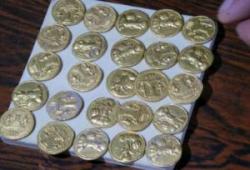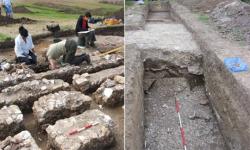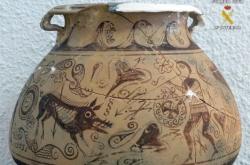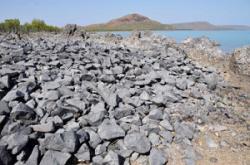INSTITUT SUPERIEUR D'ANTHROPOLOGIE
INSTITUTE OF ANTHROPOLOGY
ONLINE COURSES / COURS A DISTANCE
NEW OPEN COURSE : JANUARY 2013
HRM 104 : INTRODUCTION TO INTANGIBLE CULTURAL HERITAGE
REGISTER NOW
IRAK –  Aziziyah - Iraqi archaeologists have found 66 gold coins that are at least 1,400 years old, officials said on Monday, adding that they hope to put them on display in Baghdad's National Museum. The artefacts, which date back to the Sassanid era that extended from 225 BC to 640 AD, will be sent for laboratory tests in order to confirm their authenticity. They were discovered in the town of Aziziyah, which lies 70 kilometres (40 miles) southeast of Baghdad in Wasit province, according to Hassanian Mohammed Ali, director of the provincial antiquities department. The coins bore drawings of a king or god and depicted flames, he said.
Aziziyah - Iraqi archaeologists have found 66 gold coins that are at least 1,400 years old, officials said on Monday, adding that they hope to put them on display in Baghdad's National Museum. The artefacts, which date back to the Sassanid era that extended from 225 BC to 640 AD, will be sent for laboratory tests in order to confirm their authenticity. They were discovered in the town of Aziziyah, which lies 70 kilometres (40 miles) southeast of Baghdad in Wasit province, according to Hassanian Mohammed Ali, director of the provincial antiquities department. The coins bore drawings of a king or god and depicted flames, he said.
http://www.middle-east-online.com/english/?id=56322
ROYAUME UNI –  Faversham - Remains of a huge, 2,000-year-old Roman theatre, thought to be the first of its kind in Britain, have been discovered in Kent. Paul Wilkinson, director of the nearby Kent Archaeological Field School, and his team uncovered the remains of a cockpit-style outdoor auditorium built into a hillside in Faversham. Around 150 such theatres have been discovered across northern Europe, according to Wilkinson, but the remains are the first to be found in the UK. In addition to the orchestra pit – in which choruses would have performed – the ruins also include a narrow stage, featuring holes that are thought to have allowed flooding for aquatic displays. The theatre could have housed audiences of up to 12,000 people in 50 rows of seats over an area 65 metres in diameter. The site, which shows activity dating back as far as the bronze age, was probably used for religious festivals in which two nearby bathhouses, also uncovered by Wilkinson's team, would have played a part. Wilkinson told industry publication The Stage: "This is important for Roman archaeology because this is the first theatre of its type found in Britain. Therefore it shows that architectural practices in continental Europe at the time did seep over into Britain." Investigations at the site began in 2007, though findings were only recently announced. Wilkinson, who has submitted an application for it to become an ancient monument site with English Heritage, added: "We haven't even begun to touch on the amount of archaeology which is there." "If the full analysis of the results does confirm that the site on the outskirts of Faversham is a Roman rural theatre, it would be a most remarkable find," said Debbie Hickman, a spokesperson for English Heritage.
Faversham - Remains of a huge, 2,000-year-old Roman theatre, thought to be the first of its kind in Britain, have been discovered in Kent. Paul Wilkinson, director of the nearby Kent Archaeological Field School, and his team uncovered the remains of a cockpit-style outdoor auditorium built into a hillside in Faversham. Around 150 such theatres have been discovered across northern Europe, according to Wilkinson, but the remains are the first to be found in the UK. In addition to the orchestra pit – in which choruses would have performed – the ruins also include a narrow stage, featuring holes that are thought to have allowed flooding for aquatic displays. The theatre could have housed audiences of up to 12,000 people in 50 rows of seats over an area 65 metres in diameter. The site, which shows activity dating back as far as the bronze age, was probably used for religious festivals in which two nearby bathhouses, also uncovered by Wilkinson's team, would have played a part. Wilkinson told industry publication The Stage: "This is important for Roman archaeology because this is the first theatre of its type found in Britain. Therefore it shows that architectural practices in continental Europe at the time did seep over into Britain." Investigations at the site began in 2007, though findings were only recently announced. Wilkinson, who has submitted an application for it to become an ancient monument site with English Heritage, added: "We haven't even begun to touch on the amount of archaeology which is there." "If the full analysis of the results does confirm that the site on the outskirts of Faversham is a Roman rural theatre, it would be a most remarkable find," said Debbie Hickman, a spokesperson for English Heritage.
http://www.guardian.co.uk/stage/2013/jan/07/roman-theatre-discovered-in-kent
CHINE –  Danjiangkou - Des archéologues chinois font la course contre la montre pour récupérer des reliques à Danjiangkou, une zone qui doit être évacuée et sera inondée en 2014 pour stocker l'eau d'un énorme projet chinois de détournement d'eau. Le bureau des reliques culturelles du Henan a déclaré que depuis le lancement du programme de sauvetage d'urgence, il y a de cela sept ans, des fouilles ont été réalisées sur 123 sites archéologiques couvrant une superficie totale de 310.000 mètres carrés et que 35.000 objets avaient été déterrés. Selon une étude précédente, quatre autres sites archéologiques doivent être fouillés avant que la campagne archéologique ne s'achève à la fin de l'année. Une zone de 370 kilomètres carrés à Danjiangkou sera inondée en 2014 pour stocker de l'eau du fleuve Hanjiang, un des affluents principaux du Yangtsé. La région de Danjiangkou, située à la jonction des provinces du Henan, du Shaanxi et du Hubei, est le berceau de la culture néolithique Yangshao et de l'antique culture Chu. L'Administration nationale du patrimoine culturel a envoyé des équipes d'experts prêter main forte pour les fouilles dans cette zone riche en vestiges, permettant ainsi de mener davantage d'études archéologiques et de sauver plus de reliques avant l'évacuation du site. Les archéologues ont indiqué que parmi les reliques les plus significatives découvertes figure un tripode vieux de 2.500 ans, remontant à la période des Royaumes Combattants (475-221 avant J.C.). Le tripode en bronze, gravé de 49 caractères, est un enregistrement du chronogramme du cycle de Jupiter. Celui-ci a été découvert aux Tombeaux Xujialing, un site funéraire de la noblesse du Royaume de Chu. Cette relique est la seule preuve tangible découverte en Chine qui prouve que la chronologie était utilisée pour suivre le cycle de Jupiter.
Danjiangkou - Des archéologues chinois font la course contre la montre pour récupérer des reliques à Danjiangkou, une zone qui doit être évacuée et sera inondée en 2014 pour stocker l'eau d'un énorme projet chinois de détournement d'eau. Le bureau des reliques culturelles du Henan a déclaré que depuis le lancement du programme de sauvetage d'urgence, il y a de cela sept ans, des fouilles ont été réalisées sur 123 sites archéologiques couvrant une superficie totale de 310.000 mètres carrés et que 35.000 objets avaient été déterrés. Selon une étude précédente, quatre autres sites archéologiques doivent être fouillés avant que la campagne archéologique ne s'achève à la fin de l'année. Une zone de 370 kilomètres carrés à Danjiangkou sera inondée en 2014 pour stocker de l'eau du fleuve Hanjiang, un des affluents principaux du Yangtsé. La région de Danjiangkou, située à la jonction des provinces du Henan, du Shaanxi et du Hubei, est le berceau de la culture néolithique Yangshao et de l'antique culture Chu. L'Administration nationale du patrimoine culturel a envoyé des équipes d'experts prêter main forte pour les fouilles dans cette zone riche en vestiges, permettant ainsi de mener davantage d'études archéologiques et de sauver plus de reliques avant l'évacuation du site. Les archéologues ont indiqué que parmi les reliques les plus significatives découvertes figure un tripode vieux de 2.500 ans, remontant à la période des Royaumes Combattants (475-221 avant J.C.). Le tripode en bronze, gravé de 49 caractères, est un enregistrement du chronogramme du cycle de Jupiter. Celui-ci a été découvert aux Tombeaux Xujialing, un site funéraire de la noblesse du Royaume de Chu. Cette relique est la seule preuve tangible découverte en Chine qui prouve que la chronologie était utilisée pour suivre le cycle de Jupiter.
http://french.peopledaily.com.cn/Culture/8076341.html
ESPAGNE –  Alicante - Le propriétaire d’une boutique d’antiquités en Espagne a été arrêté après la découverte dans son commerce d’un vase datant du deuxième siècle avant Jésus-Christ, ont annoncé les autorités samedi. L’antiquité avait été pillée d’un site archéologique de la province d’Alicante, selon un communiqué du ministère de l’Intérieur. Selon Jose Luis Simon, un expert du service de l’héritage culturel du ministère de la Culture, il est difficile d’évaluer pour l’instant l’importance de la découverte. Mais le vase continuera de faire jaser dans 20 ans, a-t-il affirmé. M. Simon a indiqué que le vase arborait la peinture décorative typique de l’ère ibérique qui raconte l’histoire d’un chasseur ayant réussi à tuer un sanglier sauvage, un rituel de l’époque qui prouvait qu’un jeune homme avait atteint l’âge adulte. Il a ajouté que des fragments de vases de cette période de l’antiquité existaient en Espagne, mais que le vase en question avait été le premier à être retrouvé intact, ce qui lui donnait «une valeur exceptionnelle». L’expert a expliqué que les séquences de chasse étaient similaires à celles sur un vase grec ancien que l’on peut voir au Musée du Vatican, à Rome.
Alicante - Le propriétaire d’une boutique d’antiquités en Espagne a été arrêté après la découverte dans son commerce d’un vase datant du deuxième siècle avant Jésus-Christ, ont annoncé les autorités samedi. L’antiquité avait été pillée d’un site archéologique de la province d’Alicante, selon un communiqué du ministère de l’Intérieur. Selon Jose Luis Simon, un expert du service de l’héritage culturel du ministère de la Culture, il est difficile d’évaluer pour l’instant l’importance de la découverte. Mais le vase continuera de faire jaser dans 20 ans, a-t-il affirmé. M. Simon a indiqué que le vase arborait la peinture décorative typique de l’ère ibérique qui raconte l’histoire d’un chasseur ayant réussi à tuer un sanglier sauvage, un rituel de l’époque qui prouvait qu’un jeune homme avait atteint l’âge adulte. Il a ajouté que des fragments de vases de cette période de l’antiquité existaient en Espagne, mais que le vase en question avait été le premier à être retrouvé intact, ce qui lui donnait «une valeur exceptionnelle». L’expert a expliqué que les séquences de chasse étaient similaires à celles sur un vase grec ancien que l’on peut voir au Musée du Vatican, à Rome.
http://journalmetro.com/culture/216850/un-vase-ancien-saisi-en-espagne/
AUSTRALIE –  Kimberley - WA Museum curator Corioli Souter, who is completing a paper about the short-lived settlement, has studied contemporary accounts and conducted a brief site survey with assistant curator Jim Stedman. Occupation began in the summer of 1864-65 when three boatloads of hopeful settlers arrived on the rugged Kimberley coast, about 600km north-east of Broome, with a quantity of sheep. “A whole bunch of Melburnians had got involved, thinking they were on the back of favourable reports from people who really should know better, suggesting it would be a great place to settle,” Ms Souter says. “Of course they didn’t last a year before the sheep and a number of people died.”
Kimberley - WA Museum curator Corioli Souter, who is completing a paper about the short-lived settlement, has studied contemporary accounts and conducted a brief site survey with assistant curator Jim Stedman. Occupation began in the summer of 1864-65 when three boatloads of hopeful settlers arrived on the rugged Kimberley coast, about 600km north-east of Broome, with a quantity of sheep. “A whole bunch of Melburnians had got involved, thinking they were on the back of favourable reports from people who really should know better, suggesting it would be a great place to settle,” Ms Souter says. “Of course they didn’t last a year before the sheep and a number of people died.”
http://www.sciencewa.net.au/topics/aboriginal-science-a-knowledge/item/1854-kimberley-archaeological-site-tells-aboriginal-and-settlers-interactions.html
GRECE –  Antikythera - Underwater archaeologist Brendan Foley of the Woods Hole Oceanographic Institution announced at the Annual Meeting of the Archaeological Institute of America that the wreckage that yielded the Antikythera Mechanism is so enormous that it may actually represent two ships. In addition to the bronze calendar device, bronze and marble statues, amphora, and figurines have been recovered from the site, located in deep water near the Greek island of Antikythera. The researchers will return to the site next year with metal detectors to look for artifacts and any possibly undisturbed areas of the wreckage. “Because the site has been so intruded upon for more than a century it gets really hard to disambiguate what’s myth and what’s fact,” he said.
Antikythera - Underwater archaeologist Brendan Foley of the Woods Hole Oceanographic Institution announced at the Annual Meeting of the Archaeological Institute of America that the wreckage that yielded the Antikythera Mechanism is so enormous that it may actually represent two ships. In addition to the bronze calendar device, bronze and marble statues, amphora, and figurines have been recovered from the site, located in deep water near the Greek island of Antikythera. The researchers will return to the site next year with metal detectors to look for artifacts and any possibly undisturbed areas of the wreckage. “Because the site has been so intruded upon for more than a century it gets really hard to disambiguate what’s myth and what’s fact,” he said.
http://www.archaeology.org/news/415-130107-antikythera-wreck-return